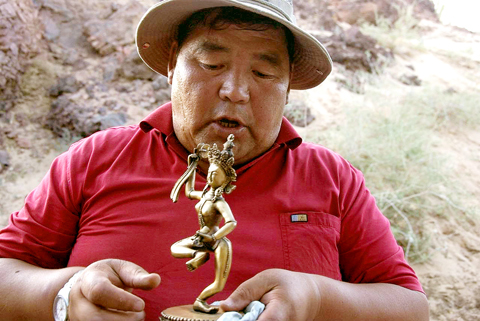Digging for buried treasure in the Gobi Desert sounds like the opening scene of an Indiana Jones film. For Austrian-born Michael Eisenriegler, it was a real-life adventure.
The 40-year-old amateur archeologist was in the Gobi over the weekend, helping to unearth Buddhist relics that had been buried for more than seven decades in a remote part of Mongolia.
Less than an hour of digging revealed two crates filled with priceless treasure, including rare manuscripts, Buddhist statues and clothing.

PHOTO: AFP
The relics were once part of a much larger cache of artwork housed at Khamaryn monastery, located 450km southeast of the capital, Ulan Bator.
The monastery was looted and destroyed by order of the communist government in 1937, but not before one monk named Tuduv hid many of the sacred objects.
Around 1,500 boxes of treasure had originally been stored at the monastery. Tuduv managed to bury 64 of them. The rest were destroyed.
Tuduv maintained the secret of the hidden crates for decades until finally revealing the story to his grandson Zundoi Altangerel.
When freedom of religion was allowed with the end of communism in 1990, Altangerel dug up a third of the boxes and placed his findings in a new museum.
Eisenriegler, an online media producer, visited the museum last year, met Altangerel and learned that many more boxes still lay hidden in the Gobi.
The museum was apparently not safe enough to house all the artifacts so Altangerel left about 20 boxes hidden in the wilderness. His grandfather had made him memorize the exact location of the crates.
Eisenriegler convinced the historian to dig up some of the boxes. That happened on Saturday with a joint team of Mongolian and Austrian experts on hand to inspect the items as they came out of the ground.
“My ancestors protected these boxes for many years. Now it is my duty to protect them,” said Altangerel after the dig. “In the future we plan to dig up the remaining crates.”
The event was filmed and streamed live on the Internet. Web users who logged on to the site, www.gobi-treasure.com, were encouraged to donate money, which will be given to Altangerel to improve his museum.
Viewers watched as the excavators spent 45 minutes digging into the earth, lifted the boxes out of the ground and displayed their contents.
The boxes housed a trove of artifacts including bronze statues, holy texts known as sutras and other riches. Altangerel carefully lifted the items out of the boxes and described their meaning.
Many were musical instruments, possibly used in Buddhist ceremonies at the monastery. He displayed a small drum that he described as a child’s toy.
The crates also contained manuscripts. Historians are interested in studying the texts, hoping they will provide clues to daily life at Khamaryn Khiid.
“We were deeply impressed with this event … These treasures were some of the most amazing things that I have seen, especially the statues,” Eisenriegler said after the dig.
The texts should also go a long way in helping historians better understand the founder of the monastery, Danzan Ravjaa, who lived from 1803 to 1856.
The legendary monk wrote hundreds of poems, performed Mongolia’s first opera and established schools and a museum. Wild legends about his miraculous feats still circulate among the Gobi nomads.
“We did this as a way to promote Danzan Ravjaa in the West,” Eisenriegler said. “He is worth being studied and known in the West. We also want Mongolians to get to know their history and Danzan Ravjaa is a big part of that.”
Danzan Ravjaa was best known for writing Mongolia’s first opera, Saran Khokhoo, or “Moon Cuckoo.” He staged the event at various monasteries across the Gobi Desert, raising money for building projects at his monastery. When Danzan Ravjaa died his mummified body was placed inside the White Temple of Khamaryn Khiid, and boxes of treasure were set around the body.
The relics remained there until the 1930s when the Mongolian army closed the monastery and arrested most of the monks, charging them with “counter-revolutionary activities.”

A fire caused by a burst gas pipe yesterday spread to several homes and sent a fireball soaring into the sky outside Malaysia’s largest city, injuring more than 100 people. The towering inferno near a gas station in Putra Heights outside Kuala Lumpur was visible for kilometers and lasted for several hours. It happened during a public holiday as Muslims, who are the majority in Malaysia, celebrate the second day of Eid al-Fitr. National oil company Petronas said the fire started at one of its gas pipelines at 8:10am and the affected pipeline was later isolated. Disaster management officials said shutting the

US Vice President J.D. Vance on Friday accused Denmark of not having done enough to protect Greenland, when he visited the strategically placed and resource-rich Danish territory coveted by US President Donald Trump. Vance made his comment during a trip to the Pituffik Space Base in northwestern Greenland, a visit viewed by Copenhagen and Nuuk as a provocation. “Our message to Denmark is very simple: You have not done a good job by the people of Greenland,” Vance told a news conference. “You have under-invested in the people of Greenland, and you have under-invested in the security architecture of this

UNREST: The authorities in Turkey arrested 13 Turkish journalists in five days, deported a BBC correspondent and on Thursday arrested a reporter from Sweden Waving flags and chanting slogans, many hundreds of thousands of anti-government demonstrators on Saturday rallied in Istanbul, Turkey, in defence of democracy after the arrest of Istanbul Mayor Ekrem Imamoglu which sparked Turkey’s worst street unrest in more than a decade. Under a cloudless blue sky, vast crowds gathered in Maltepe on the Asian side of Turkey’s biggest city on the eve of the Eid al-Fitr celebration which started yesterday, marking the end of Ramadan. Ozgur Ozel, chairman of the main opposition Republican People’s Party (CHP), which organized the rally, said there were 2.2 million people in the crowd, but

JOINT EFFORTS: The three countries have been strengthening an alliance and pressing efforts to bolster deterrence against Beijing’s assertiveness in the South China Sea The US, Japan and the Philippines on Friday staged joint naval drills to boost crisis readiness off a disputed South China Sea shoal as a Chinese military ship kept watch from a distance. The Chinese frigate attempted to get closer to the waters, where the warships and aircraft from the three allied countries were undertaking maneuvers off the Scarborough Shoal — also known as Huangyan Island (黃岩島) and claimed by Taiwan and China — in an unsettling moment but it was warned by a Philippine frigate by radio and kept away. “There was a time when they attempted to maneuver